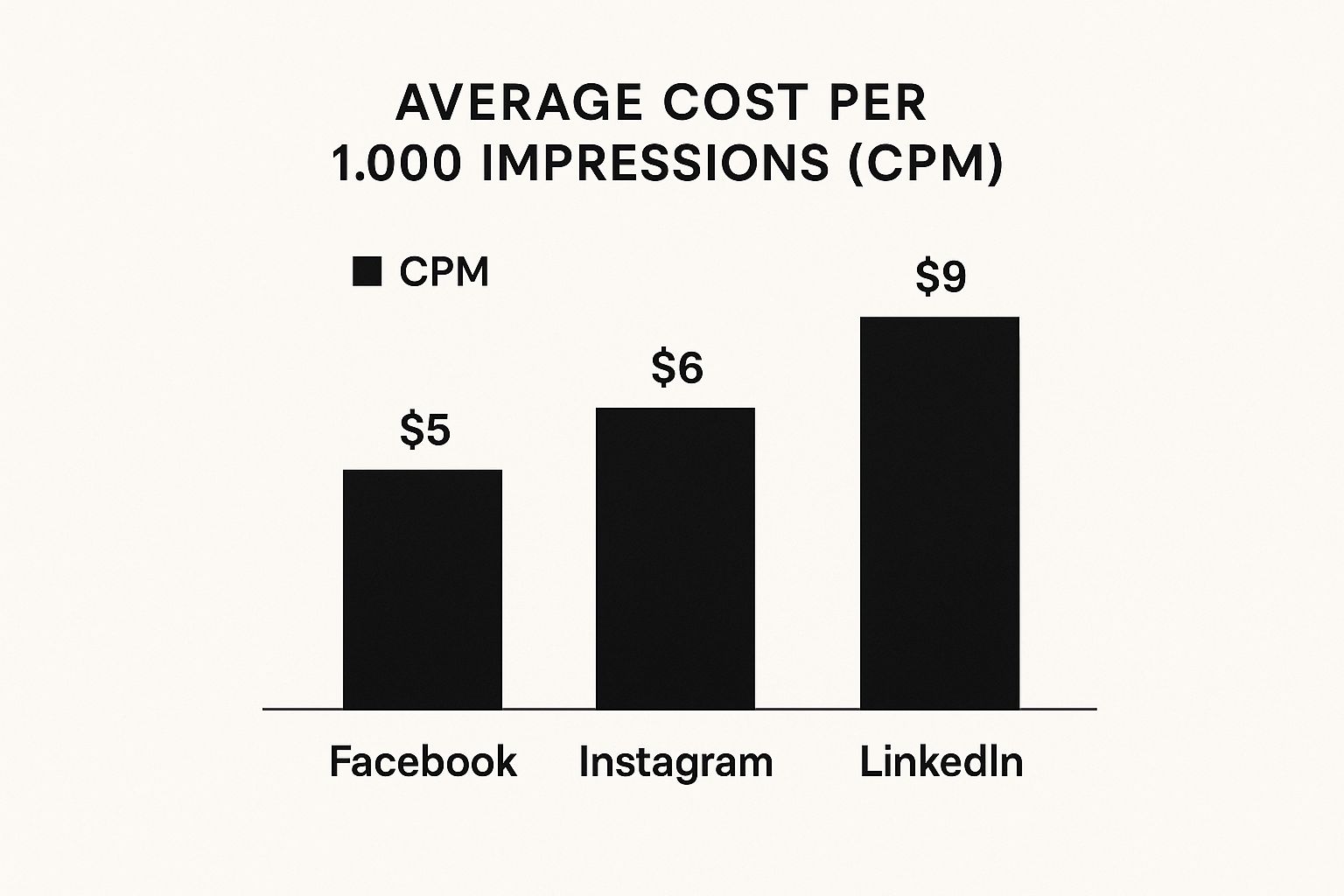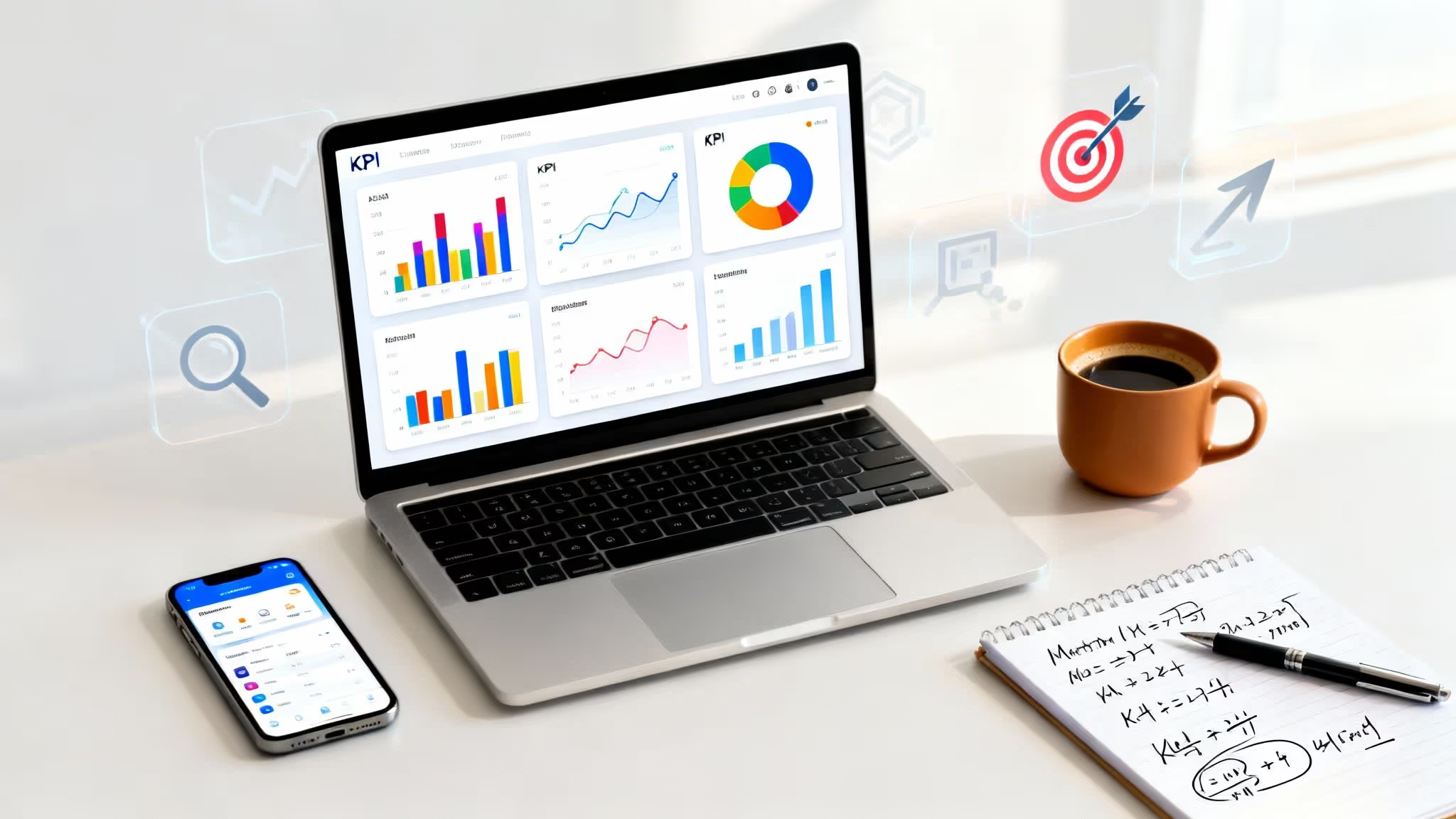The true cost of professional social media marketing can range from $450 to over $6,000 per month for management services alone. On top of that, your advertising spend could be anywhere from a few hundred dollars to tens of thousands, depending on your goals.
Think of it like commissioning custom furniture. The final price tag depends on the materials you choose, the complexity of the design, and the artisan's skill. Your investment in social media works the same way—it's tailored to your business objectives and the ambition of your strategy.
What Businesses Actually Pay for Social Media Marketing
When people ask about social media marketing cost, they're typically asking two distinct questions: how much for professional management, and how much for the ads themselves? Distinguishing between these is the first step toward building a sensible budget.
The management fee covers expertise—strategy, content creation, and campaign oversight. Ad spend is the money paid directly to platforms like Meta or LinkedIn to place your content in front of a target audience. One is the cost of skill; the other is the cost of visibility. You need both. A brilliant strategy with no ad spend will struggle for reach, while a huge ad budget with a weak strategy is an expensive way to burn cash.
Average Monthly and Annual Investments
So, what are businesses really spending? Globally, the average annual investment in social media advertising lands between $10,000 and $25,000. This figure often includes technology, creative assets, and professional management fees.
On a monthly basis, management fees typically fall between $850 and $2,000. Remember, this covers the agency or freelancer's time and expertise but excludes what you'll actually spend on the ads. You can explore these figures further with cost breakdowns from WebFX's research.
This provides a solid baseline. A small local business might stick to the lower end, while a larger company aiming for aggressive growth will naturally invest more.
A good rule of thumb is to allocate 10-20% of your total marketing budget to social media. If your business is new, you might even increase that percentage to build crucial initial awareness and attract your first customers.
Before setting anything in stone, let's examine how your budget can shift based on your objectives.
Typical Social Media Marketing Cost Breakdown (Monthly)
To provide a clearer picture, here’s a table that breaks down what you can generally expect to pay each month. This summary should help you quickly pinpoint a budget range that aligns with your business's current needs and resources.
As you can see, the total investment combines management fees and ad spend. A "Basic" plan is great for maintaining a presence, while "Premium" services are geared toward aggressive growth, lead generation, and complex, multi-platform campaigns.
Setting Realistic Budget Expectations
Before committing a single dollar, you must connect your spending to your goals. Are you trying to build brand awareness, or do you need to generate qualified leads immediately? Each objective demands a different level of financial commitment.
Here’s a simple way to think about it:
- Brand Awareness: This goal often relies on high-quality, engaging organic content, supplemented with a modest ad spend to boost top-performing posts and expand reach.
- Lead Generation: This requires a more significant ad spend. You're not just boosting posts; you're running targeted campaigns to drive traffic to specific landing pages, making it a more direct investment.
- Direct Sales (eCommerce): This is the most performance-driven goal and usually demands the highest ad spend. You'll run conversion-focused campaigns, retarget shoppers, and continuously optimize for sales.
Setting clear expectations from the start helps you avoid budget blowouts and ensures every dollar spent is tied to a measurable outcome. The cost isn't an arbitrary number; it's a direct reflection of your ambition.
Key Factors That Drive Your Social Media Budget

Determining your social media marketing cost isn't like picking a product off a shelf. It’s a custom build, where your specific goals and choices dictate the final price. A few core factors will scale your investment up or down, turning a vague idea of "cost" into a calculated plan. Let's break down exactly what drives your spending.
Business Goals and Objectives
The single biggest factor shaping your budget is what you want to accomplish. A campaign designed simply to increase visibility will cost far less than one laser-focused on driving immediate sales.
Brand Awareness: If your main goal is to introduce your brand, you'll likely focus on creating excellent content and boosting posts to reach a wide audience. The key metrics are impressions and engagement, which can often be achieved with a more modest ad spend.
Lead Generation and Sales: When you're pursuing leads or e-commerce sales, the investment naturally increases. This requires a more aggressive ad strategy, sophisticated audience targeting, high-converting landing pages, and continuous optimization to ensure a positive return.
The closer your goal is to a transaction, the more you should expect to invest in performance-driven advertising.
Target Audience Complexity
Who you're trying to reach directly impacts your costs. It's a simple case of supply and demand—some audiences are more expensive to target because everyone wants their attention.
Consider the difference between a B2C fashion brand and a B2B software company. The fashion brand might target a broad demographic on Instagram based on interests like "online shopping." It's a massive audience, so the cost per click is relatively low.
However, the B2B company might need to reach C-suite executives in the financial services industry on LinkedIn. This is a much smaller, highly specific, and valuable group. Because so many companies are competing for the attention of these decision-makers, the cost per click (CPC) can easily be 5 to 10 times higher.
Your audience's value sets the price at the advertising auction. Targeting a high-value, niche audience is like bidding on prime real estate—the competition is fierce, and the price tag reflects the potential payoff.
Scope of Services Required
Your social media marketing cost also hinges on the specific services you need. Are you looking for someone to schedule a few posts, or do you require a full team to handle everything from strategy and content to advertising and reporting?
The scope of work can cover a spectrum of tasks, each adding to the cost:
- Strategy Development: Crafting a detailed roadmap aligned with your business goals.
- Content Creation: Designing graphics, writing compelling copy, and producing videos.
- Community Management: Engaging with followers and handling comments and messages.
- Paid Ad Management: Building, running, and optimizing ad campaigns.
- Analytics and Reporting: Tracking performance and delivering insights to guide future decisions.
A basic package might only cover content scheduling, while a comprehensive retainer will bring in a team of specialists. When evaluating paid social management services, ensure you receive a crystal-clear breakdown of deliverables to understand the true value of your investment.
Choosing Your Team: In-House vs. Agency vs. Freelancer
One of the biggest levers on your total social media marketing cost is deciding who will perform the work. This is a strategic choice between different operational models, each with its own price tag and a unique set of pros and cons. Are you looking for a dedicated brand expert, a flexible specialist, or a full-service strategic partner? Let's break down what each option means for your budget and goals.
The True Cost of an In-House Team
Hiring an in-house social media manager often seems like the most direct path. You get a dedicated employee completely immersed in your brand and company culture. But their salary is just the beginning.
To get the real number, you must calculate the "fully-loaded" cost, which includes necessary expenses beyond a paycheck:
- Benefits and Taxes: Health insurance, retirement contributions, and payroll taxes can easily add 20-30% on top of a base salary.
- Tools and Technology: A professional needs professional tools. You'll be footing the bill for scheduling software, analytics platforms, and content creation apps, which can cost thousands of dollars annually.
- Training and Development: Social media changes rapidly. To keep their skills sharp, you'll need to invest in ongoing training, courses, and industry conferences.
When you do the math, a manager with a $70,000 salary can quickly become a $95,000+ annual expense. This model offers unparalleled brand integration but demands a significant, long-term financial commitment.
The Flexibility of a Freelancer
Freelancers offer a level of flexibility and affordability that is hard to beat. They typically charge by the hour or on a per-project basis, allowing you to scale their involvement up or down as your needs and budget change.
Hourly rates for a seasoned social media freelancer can range from $50 to over $200, depending on their expertise and the scope of work. This is a fantastic option for businesses that need specialized skills for a short-term campaign or lack the workload to justify a full-time hire.
Hiring a freelancer is like calling in a specialist. You get targeted expertise precisely when you need it, without the overhead and long-term commitment of a full-time employee.
The trade-off? While freelancers are cost-effective, they are not as deeply embedded in your company culture. You’re hiring their specific skill set, not their undivided attention, as they almost always juggle multiple clients.
This infographic breaks down a key metric your team will manage—the average cost per 1,000 impressions (CPM) on major platforms.

As you can see, reaching the same audience on LinkedIn can cost nearly double what it does on Facebook. This is a perfect example of how platform choice directly impacts your ad spend.
The Strategic Partnership of an Agency
Working with a marketing agency is the middle ground between a solo freelancer and a full in-house team. An agency gives you access to an entire team of specialists—strategists, copywriters, designers, and ad managers—for a single monthly retainer.
Agency retainers generally fall between $900 and $6,000+ per month, not including your ad spend. Some also work on a percentage-of-ad-spend model, usually 10-20%, which ties their fee directly to the scale of your campaigns.
This model delivers a breadth of expertise that would be incredibly expensive to hire individually. You can dive deeper into the strategic advantages by exploring the benefits of hiring a marketing agency and seeing how their structure is built for growth. The main trade-off is that an agency serves a portfolio of clients, so they won't be exclusively focused on your brand like a dedicated employee.
In-House vs. Freelancer vs. Agency Cost-Benefit Analysis
To make the decision clearer, let's compare these three models side-by-side. Each has distinct advantages depending on your company's stage, budget, and strategic priorities.
Ultimately, there is no single "right" answer. The best choice hinges on your specific budget, your need for specialized skills, and how deeply you want your social media function integrated into your day-to-day operations.
Uncovering the Hidden Costs of Social Media

Calculating your social media marketing budget is like booking a flight. You see the base fare, but after taxes and fees, the final price looks quite different. Similarly, an effective social media budget accounts for more than just agency fees and ad spend.
Many businesses are caught off guard by these secondary—but essential—investments. These aren't "hidden" costs in a deceptive sense; they're the necessary resources that fuel high-performing campaigns. By anticipating them, you can build a realistic budget that won’t leave you scrambling.
The Real Price of High-Quality Content
Content is the engine of your social media presence, and that engine needs premium fuel. While it's tempting to rely on a smartphone, today's audiences have high expectations and reward professional, compelling visuals. The cost of creating this content is one of the most underestimated parts of most social media budgets.
This is where your investment can quickly add up:
- Professional Photography and Videography: Stock photos have a place, but nothing beats custom imagery that captures your brand's unique personality. A single professional photoshoot can cost $500 to $5,000, and video production costs are often even higher.
- Graphic Design: Consistent, polished graphics make a brand instantly recognizable. Whether you hire a freelancer or subscribe to premium design software, this is an ongoing cost.
- Copywriting: Writing captions that engage, persuade, and convert is a genuine skill. If you lack a strong writer on your team, you may need to budget for a professional to ensure your message resonates.
Essential Software and Tools
Running a modern social media strategy without the right tools is like building a house with only a hammer. You need a full toolkit to manage, analyze, and optimize your efforts efficiently.
Think of your management platform as your digital command center. It saves you from the chaos of manual posting and provides the data needed for intelligent, data-driven decisions.
These software subscriptions are a recurring operational cost you cannot forget:
- Scheduling and Management Platforms: Tools like Sprout Social or Hootsuite are vital for planning content calendars and maintaining a consistent presence. Plans can range from $50 to over $500 per month.
- Analytics and Reporting Tools: To truly measure your ROI, you need software that offers deeper insights than native platforms provide.
- Content Creation Software: Subscriptions to platforms like Adobe Creative Cloud or Canva Pro are often essential for design work.
Collaborations and Community Engagement Costs
Beyond content and software, your budget needs room for activities that accelerate growth and build a real community. Think of these as investments in relationships, not just broadcasting messages.
Influencer marketing is one of the most powerful strategies. Costs can vary wildly, but even a campaign with micro-influencers might require a budget of $1,000 to $10,000 for their fees and gifted products.
Running contests or giveaways is another proven way to boost engagement. However, you must plan for the cost of the prize, plus any ad spend needed to promote the campaign. These are not just fun extras; they are strategic expenses designed to create buzz and build a loyal following.
How Market Trends and Seasonality Can Wreck Your Ad Budget
Your social media marketing cost isn't a fixed number you can set and forget. It’s dynamic, moving with the rhythms of the market. Think of it like a bustling auction house: when everyone wants to bid on the same item at the same time, the price skyrockets. The same thing happens to your ad spend.
This fluctuation is surprisingly predictable. Seasonality is a huge driver, especially for consumer-facing businesses. A swimwear brand, for instance, knows that competition—and ad costs—will rise in spring and summer. Conversely, a tax preparation service will face its most expensive ad buys in Q1.
Understanding this rhythm allows you to build a smarter, more flexible budget. You can anticipate price hikes, pull back strategically, or find quieter, less competitive times to make every dollar work harder.
The Q4 Spike and Other Major Events
Nothing demonstrates this better than the fourth quarter. The shopping frenzy that begins with Black Friday and Cyber Monday creates a massive advertising tidal wave, driving up costs for everyone. During this period, retailers pay a premium to get in front of holiday shoppers, increasing ad prices across the entire ecosystem.
If you’re not a retailer, this "holiday tax" can feel unfair, as your ads for B2B software or services compete for the same eyeballs as giant retail brands with deep pockets.
This is where savvy marketers adapt. They either increase their ad spend to stay competitive or strategically pull back to avoid the crush. They might shift focus to organic content or plan major campaigns for less chaotic periods, like Q1, when costs almost always drop.
Platform Changes and Algorithm Mood Swings
It’s not just about seasons. The social media platforms themselves are a constant source of volatility. We’ve seen ad costs fluctuate wildly in recent years due to market dynamics, with platforms tracking metrics like CPM (cost per thousand impressions) to measure campaign efficiency. Unsurprisingly, data from firms like Gupta Media shows that CPMs consistently spike around major retail events, forcing marketers to adapt on the fly.
These shifts aren't always predictable. A platform can release an algorithm update overnight that completely changes the rules. For example, when a platform prioritizes a new format like short-form video, the cost to promote older formats might increase as their organic reach declines. Agility is key.
This can also work in your favor. The explosive growth of a new platform can create cost-effective advertising opportunities. As you explore these dynamics, understanding each network's quirks is helpful. For a great example, check out our guide on how much TikTok ads cost to see how newer platforms can offer a different value proposition.
By treating your ad spend as a variable, not a fixed expense, you can learn to move with the market's pulse, sidestep the most expensive fights, and achieve a healthier return on your investment.
From Cost to Investment: Calculating Your Social Media ROI

Let's shift the conversation. Social media isn't just another expense—it's an investment. The key is to treat it that way. Every dollar you put into content, ads, or management should work to deliver a tangible business result. This is where Return on Investment (ROI) becomes an essential tool.
At its core, ROI answers one simple question: is the money spent on social media bringing in more value than it costs? A positive ROI means you're profitable. A negative one is a clear signal that it's time to reassess your strategy.
Key Metrics for Measuring Social Media ROI
To get a real sense of your ROI, you must look beyond vanity metrics like likes and shares. Instead, zero in on data that ties directly to your bottom line. These numbers tell the true story of how your investment is performing.
Here are the metrics that actually matter:
- Customer Acquisition Cost (CAC): This is the total cost of your social media efforts divided by the number of new customers acquired. A lower CAC indicates higher efficiency.
- Customer Lifetime Value (LTV): This metric forecasts the total revenue you can expect from a single customer over their entire relationship with your brand. The goal is to ensure a customer's LTV is significantly higher than their CAC.
- Lead Conversion Rate: This is the percentage of leads generated from social media who become paying customers. It directly measures how effectively your campaigns turn interest into revenue.
Tracking these figures allows you to draw a straight line from a specific ad or post to a signed contract. If you're looking to dig deeper, we break it down further in our guide to measuring social media ROI.
A Simple Framework for ROI Calculation
You don't need an advanced degree in data science to calculate ROI. The basic formula is surprisingly simple yet provides a powerful snapshot of your campaign's financial health.
(Revenue from Social Media – Total Social Media Cost) / Total Social Media Cost x 100 = Social Media ROI %
Let's make that tangible. Say you generated $10,000 in revenue from a campaign that cost $2,500 to run. Your ROI would be a very healthy 300%. This simple math transforms your social media budget from a guess into a proven revenue generator.
Globally, social media ad spending is projected to reach $276.7 billion. Being able to point to a positive ROI is the best way to justify your budget. It empowers you to request more resources and make data-backed decisions that fuel real, sustainable growth.
Got Questions? We’ve Got Answers.
When determining social media marketing costs, many questions arise. Let's tackle some of the most common ones to help you finalize your budget with confidence.
What’s a Realistic Starting Budget for Social Media Marketing?
You can absolutely get started with a budget between $500 to $1,000 per month. This is enough to cover a basic management fee and begin experimenting with paid ads.
Think of this as your "testing ground" budget. It’s perfect for building initial brand awareness and running small, targeted campaigns. It allows you to discover which platforms and messages resonate with your audience before committing to a larger investment.
Which Social Media Platform Is the Most Expensive for Ads?
Without a doubt, LinkedIn is the most expensive platform for advertising. The cost-per-click (CPC) on LinkedIn can easily be 5 to 10 times higher than on Facebook or Instagram.
Why the high price tag? It's all about the audience. LinkedIn offers unparalleled targeting capabilities based on job title, industry, and company size. For B2B businesses trying to reach specific decision-makers, it’s a goldmine. The premium cost reflects the massive potential return of landing even one major client.
Don't let the sticker shock fool you. While LinkedIn's upfront costs are higher, its laser-focused targeting often leads to a lower Customer Acquisition Cost (CAC) for B2B companies in the long run. The quality of leads can more than justify the initial spend, proving that "expensive" isn't always the same as "less profitable."
Should I Spend More on Content Creation or on Ads?
This is a classic debate with no single right answer, as it depends entirely on your objectives. Here’s a simple framework to guide your decision.
- If your goal is Brand Awareness: Allocate more of your budget to creating top-notch content. You're playing the long game, building an organic presence that attracts followers. High-quality photos, compelling videos, and sharp graphics are your primary tools. Use a smaller portion of the budget for ads, mainly to boost your best-performing posts.
- If your goal is Lead Generation and Sales: Tilt the budget in favor of ad spend. Good content is still essential, but your primary mission is to drive immediate action. A larger ad budget is crucial for running conversion-focused campaigns, reaching new audiences, and retargeting interested users.
For a balanced approach, a 60/40 split—60% on ad spend and 40% on content and management—is a great starting point. From there, monitor the data. Let performance and your evolving goals dictate adjustments, ensuring your high-quality content and powerful ads work in harmony.
Ready to stop guessing and start building a social media strategy that actually delivers? At Twelverays, we create data-driven campaigns that tie every dollar you spend to real-world results. Discover how our paid social services can drive growth for your business.





